国际商务(英语)-教学大纲
- 格式:docx
- 大小:40.62 KB
- 文档页数:14
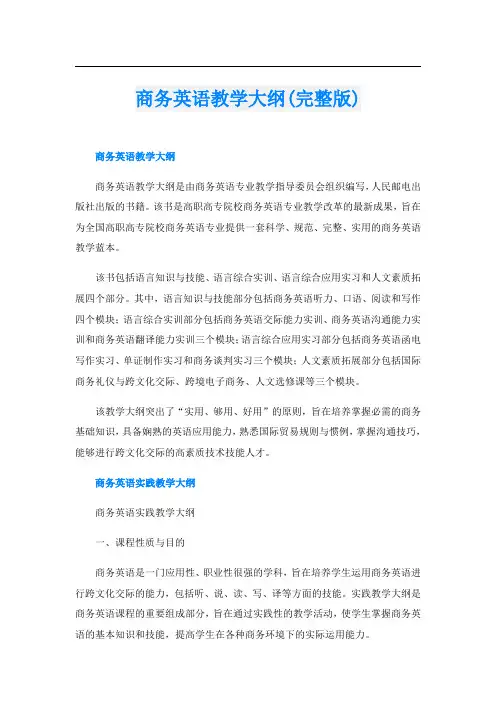
商务英语教学大纲(完整版)商务英语教学大纲商务英语教学大纲是由商务英语专业教学指导委员会组织编写,人民邮电出版社出版的书籍。
该书是高职高专院校商务英语专业教学改革的最新成果,旨在为全国高职高专院校商务英语专业提供一套科学、规范、完整、实用的商务英语教学蓝本。
该书包括语言知识与技能、语言综合实训、语言综合应用实习和人文素质拓展四个部分。
其中,语言知识与技能部分包括商务英语听力、口语、阅读和写作四个模块;语言综合实训部分包括商务英语交际能力实训、商务英语沟通能力实训和商务英语翻译能力实训三个模块;语言综合应用实习部分包括商务英语函电写作实习、单证制作实习和商务谈判实习三个模块;人文素质拓展部分包括国际商务礼仪与跨文化交际、跨境电子商务、人文选修课等三个模块。
该教学大纲突出了“实用、够用、好用”的原则,旨在培养掌握必需的商务基础知识,具备娴熟的英语应用能力,熟悉国际贸易规则与惯例,掌握沟通技巧,能够进行跨文化交际的高素质技术技能人才。
商务英语实践教学大纲商务英语实践教学大纲一、课程性质与目的商务英语是一门应用性、职业性很强的学科,旨在培养学生运用商务英语进行跨文化交际的能力,包括听、说、读、写、译等方面的技能。
实践教学大纲是商务英语课程的重要组成部分,旨在通过实践性的教学活动,使学生掌握商务英语的基本知识和技能,提高学生在各种商务环境下的实际运用能力。
二、实践教学的主要内容与要求1.商务英语听说训练:通过模拟商务场景和角色扮演,使学生掌握商务英语口语和听力技能,能够进行基本的商务交流和谈判。
2.商务英语阅读训练:通过阅读商务文献、案例和报告等材料,使学生掌握商务英语阅读技巧和方法,能够理解并分析各种商务问题。
3.商务英语写作训练:通过写作商务文书、邮件和报告等材料,使学生掌握商务英语写作技巧和方法,能够撰写规范的商务文书。
4.商务英语翻译训练:通过翻译各种商务文本,使学生掌握商务英语翻译技巧和方法,能够准确、流畅地进行商务文本翻译。
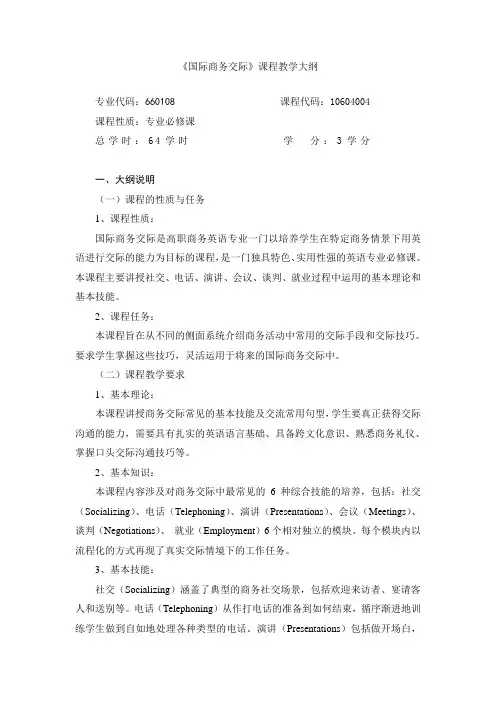
《国际商务交际》课程教学大纲专业代码:660108课程代码:10604004课程性质:专业必修课总学时:64学时学分:3学分一、大纲说明(一)课程的性质与任务1、课程性质:国际商务交际是高职商务英语专业一门以培养学生在特定商务情景下用英语进行交际的能力为目标的课程,是一门独具特色、实用性强的英语专业必修课。
本课程主要讲授社交、电话、演讲、会议、谈判、就业过程中运用的基本理论和基本技能。
2、课程任务:本课程旨在从不同的侧面系统介绍商务活动中常用的交际手段和交际技巧。
要求学生掌握这些技巧,灵活运用于将来的国际商务交际中。
(二)课程教学要求1、基本理论:本课程讲授商务交际常见的基本技能及交流常用句型,学生要真正获得交际沟通的能力,需要具有扎实的英语语言基础、具备跨文化意识、熟悉商务礼仪、掌握口头交际沟通技巧等。
2、基本知识:本课程内容涉及对商务交际中最常见的6种综合技能的培养,包括:社交(Socializing)、电话(Telephoning)、演讲(Presentations)、会议(Meetings)、谈判(Negotiations)、就业(Employment)6个相对独立的模块。
每个模块内以流程化的方式再现了真实交际情境下的工作任务。
3、基本技能:社交(Socializing)涵盖了典型的商务社交场景,包括欢迎来访者、宴请客人和送别等。
电话(Telephoning)从作打电话的准备到如何结束,循序渐进地训练学生做到自如地处理各种类型的电话。
演讲(Presentations)包括做开场白,运用肢体语言,运用演示工具,结束演讲等内容。
会议(Meeting)涉及召集会议,开始会议,控制会议,打断对方发言以及撰写会议议程及会议记录。
谈判(Negotiations)涉及准备,开始进行谈判,陈述观点,解决争端和迫使对方妥协等内容。
求职(Employment Communication)包括分析自我,分析市场,获取就业信息,准备简历到最后的面试成功等内容。
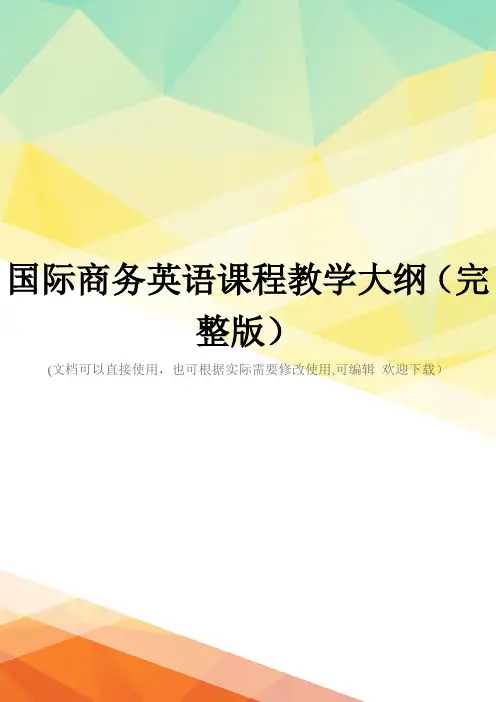
国际商务英语课程教学大纲(完整版)(文档可以直接使用,也可根据实际需要修改使用,可编辑欢迎下载)《国际商务英语》课程教学大纲(Foreign Trade English)课程类型:专业必修课课程编号:N063226适用专业:国际贸易实务专业先修课程:大学英语后续课程:剑桥商务英语,商务英语写作学分:3.5分总学时:56学时其中理论学时:40学时, 实验或上机学时:16学时教学目的与要求:本课程的教学目的:本课程的教学目的是使学生打好学习国际商务英语的专业基础。
通过掌握商务英语的基本词汇,融合大学英语的功底,能熟练阅读商务英语文章。
通过本课程的学习达到以下教学要求:1、知识:结合专业英语学习,扩充有关的外贸业务知识。
熟练掌握一种专业外语,就要熟悉该专业的业务知识。
因此学生在学习本课程时,要注意掌握课文内容和有关的业务知识。
学生应通过本课程的学习,获得大量的有关国际贸易领域的知识。
2、技能:外贸英语虽然是专业课程,但英语综合技能是学好本课程的基础。
因此,在学习本课程的过程中要进一步加强基础英语训练。
没有扎实的英语基本功,“国际商务英语”也很难学好。
3、能力:通过本课程学习,加强商务英语的阅读能力。
本课程为考查课程。
考核方式为闭卷笔试,考试题型一般设有名词解释题、阅读理解题、选择题、翻译题、问答题、案例分析题等。
考核成绩采用百分制评定,平时成绩占30%,期末成绩占70%。
Lesson One The Changing World and DevelopmentText: Changing World and DevelopmentNew WordsSpecial TermsIdioms and ExpressionsWord Study: trade, export & import, and advantages.Additional Reading: E-Life ComprehensionNew words and ExpressionsLesson Two International TradeText: International TradeNews WordsSpecial TermsIdioms and ExpressionsWord Study:Produce, Offer, Quote, Order.Additional Reading: Unique Problems in International Trade New Words and ExpressionsLesson Three Import and ExportText: Import and ExportNew WordsSpecial TermsIdioms and ExpressionsWord Study: Negotiate, Contract, Pay, ShipAdditional Reading: Shipping, Insurance and Customs News Words and ExpressionsLesson Four Letters of CreditText: Letters of CreditNews WordsSpecial TermsIdioms and ExpressionsWord Study: Credit, Stipulate, Confirm, DealLesson Five Trade InformationText:Trade InformationNews WordsSpecial TermsIdioms and ExpressionsWord Study: Market, Involve, Price, ServiceLesson Six Keeping the Customer Satisfied Text:Keeping the Customer SatisfiedNews WordsSpecial TermsIdioms and ExpressionsWord Study: Inform, Value, Commit, CoverLesson Seven Fortune 500Text: Fortune 500News WordsSpecial TermsIdioms and ExpressionsWord Study: Supply, Demand, Firm, StockLesson Eight The Spread of CHINA INCText: The Spread of CHINA INCNews WordsSpecial TermsIdioms and ExpressionsWord Study: Business, Interest, Manage, CostLesson Nine The European UnionText: The European UnionNews WordsSpecial TermsIdioms and ExpressionsWord Study: Average, Bid, Transact, Increase, CompeteAdditional Reading: The EuroNews Words and ExpressionsLesson Ten Transnational CorporationText: Transnational CorporationNews WordsSpecial TermsIdioms and ExpressionsWord Study: Charge, Share, Contribute, IssueAdditional Reading: Third World PowerhousesNews Words and ExpressionsLesson Eleven The Balance of International PaymentsText: The Balance of International PaymentsNews WordsSpecial TermsIdioms and ExpressionsWord Study: Balance, Account, Engage, ConsiderAdditional Reading: The Securities ExchangeNews Words and ExpressionsLesson Twelve Foreign Exchange TradingText: Foreign Exchange TradingNews WordsSpecial TermsIdioms and ExpressionsWord Study: Exchange, Convert, Worth, RateAdditional Reading: Quarterly Market Report— Global Market Perspective News Words and ExpressionsLesson Thirteen The World Bank and the International Monetary Fund Text: The World Bank and the International Monetary FundNews WordsSpecial TermsIdioms and ExpressionsWord Study: Spread, Concern, Proceed, PremiumAdditional Reading: The Joint International VentureNews Words and ExpressionsLesson Fourteen Japan’s Stumbling GiantsText: Japan’s Stumbling GiantsNews WordsSpecial TermsIdioms and ExpressionsWord Study: Economy, Benefit, Apply, PayAdditional Reading: US Needs New Thinking on Global Trade News Words and ExpressionsLesson Fifteen WTO Agrees on New Round to Open MarketsText: WTO Agrees on New Round to Open MarketsNews WordsSpecial TermsIdioms and ExpressionsWord Study: Vary, Insure, Clear, AcceptAdditional Reading: WTO and Its IroniesNews Words and ExpressionsLesson Sixteen The Leadership Primer (I)Text: The Leadership Primer (I)News WordsSpecial TermsIdioms and ExpressionsWord Study: Agree, Limit, Favor, ClaimAdditional Reading: The Leadership Primer (II)News Words and Expressions实践教学商务英语强化实训(1周)实训技能和要求:1、英语语言技能:具备以英语为工作语言的能力。
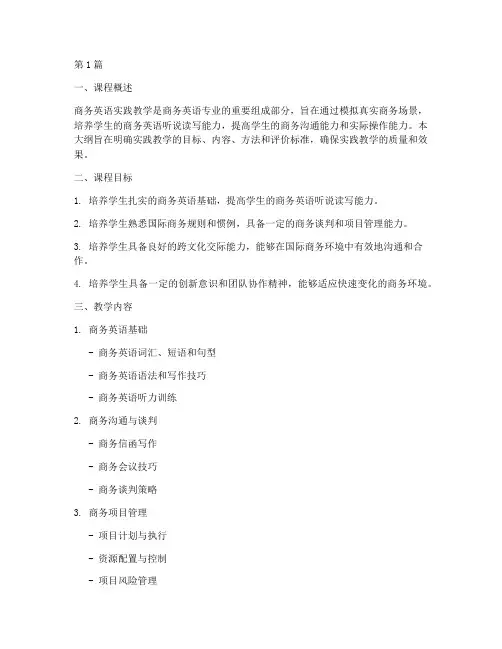
第1篇一、课程概述商务英语实践教学是商务英语专业的重要组成部分,旨在通过模拟真实商务场景,培养学生的商务英语听说读写能力,提高学生的商务沟通能力和实际操作能力。
本大纲旨在明确实践教学的目标、内容、方法和评价标准,确保实践教学的质量和效果。
二、课程目标1. 培养学生扎实的商务英语基础,提高学生的商务英语听说读写能力。
2. 培养学生熟悉国际商务规则和惯例,具备一定的商务谈判和项目管理能力。
3. 培养学生具备良好的跨文化交际能力,能够在国际商务环境中有效地沟通和合作。
4. 培养学生具备一定的创新意识和团队协作精神,能够适应快速变化的商务环境。
三、教学内容1. 商务英语基础- 商务英语词汇、短语和句型- 商务英语语法和写作技巧- 商务英语听力训练2. 商务沟通与谈判- 商务信函写作- 商务会议技巧- 商务谈判策略3. 商务项目管理- 项目计划与执行- 资源配置与控制- 项目风险管理4. 跨文化商务交际- 文化差异与商务礼仪- 跨文化沟通技巧- 跨文化谈判策略5. 商务英语实践项目- 模拟商务场景- 商务案例分析- 商务英语演讲与辩论四、教学方法1. 案例分析法:通过分析真实的商务案例,引导学生掌握商务英语的应用技巧。
2. 角色扮演法:模拟真实商务场景,让学生扮演不同角色,进行商务沟通和谈判。
3. 小组讨论法:鼓励学生分组讨论,培养团队协作精神和创新意识。
4. 实践操作法:通过商务英语写作、演讲、辩论等实践活动,提高学生的实际操作能力。
5. 计算机辅助教学:利用多媒体教学资源,提高教学效果。
五、实践教学安排1. 第一学期- 商务英语基础:每周2课时,共16周- 商务沟通与谈判:每周2课时,共16周- 商务英语实践项目:每周2课时,共16周2. 第二学期- 商务项目管理:每周2课时,共16周- 跨文化商务交际:每周2课时,共16周- 商务英语实践项目:每周2课时,共16周六、评价标准1. 学生参与度:评价学生在实践教学中的参与程度和积极性。
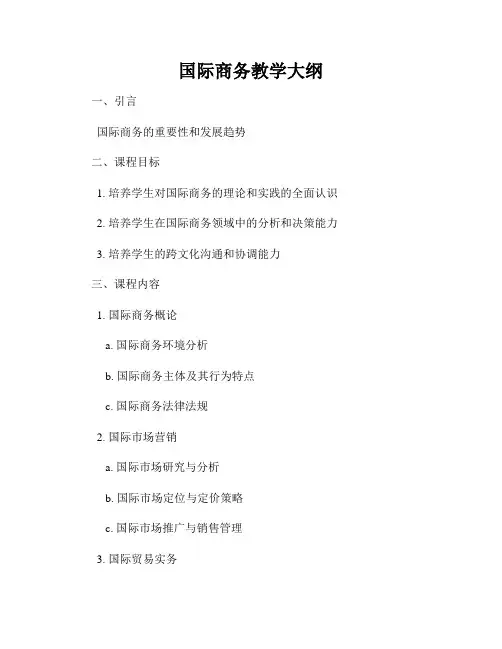
国际商务教学大纲一、引言国际商务的重要性和发展趋势二、课程目标1. 培养学生对国际商务的理论和实践的全面认识2. 培养学生在国际商务领域中的分析和决策能力3. 培养学生的跨文化沟通和协调能力三、课程内容1. 国际商务概论a. 国际商务环境分析b. 国际商务主体及其行为特点c. 国际商务法律法规2. 国际市场营销a. 国际市场研究与分析b. 国际市场定位与定价策略c. 国际市场推广与销售管理3. 国际贸易实务a. 国际贸易政策与制度b. 国际贸易操作流程与文件c. 国际贸易融资与结算方式4. 跨文化管理a. 跨文化沟通与协商技巧b. 跨文化冲突解决与合作技能c. 跨文化团队建设与管理5. 国际商务伦理与社会责任a. 国际商务道德与法律规范b. 社会责任与可持续发展c. 跨国企业的社会形象与公关策略四、教学方法1. 授课a. 理论讲解与案例分析b. 视频展示与互动讨论2. 学生参与a. 小组讨论与演示b. 学生报告与项目策划3. 实践教学a. 实地考察与企业访谈b. 国际商务模拟与角色扮演五、教学评估1. 课堂表现评估a. 平时出勤与主动参与情况b. 课堂讨论与表达能力2. 作业与项目评估a. 个人或小组作业质量b. 项目策划与实施情况3. 考试评估a. 知识与理解题b. 分析与应用题六、参考教材1. Hill, C.W.L., & Hult, G.T.M. (2019). International business: Competing in the global marketplace.2. Czinkota, M.R., & Ronkainen, I.A. (2019). International marketing.3. Keegan, W.J., & Green, M.C. (2017). Global marketing.七、教学团队主讲教师:XXX配合教师:XXX八、课程备注1. 课程重点突出学生的实践能力培养2. 学生需具备一定的英语听说读写能力3. 课程内容可能根据实际情况进行调整与更新以上为国际商务教学大纲,旨在为学生全面介绍国际商务的相关知识和技能。
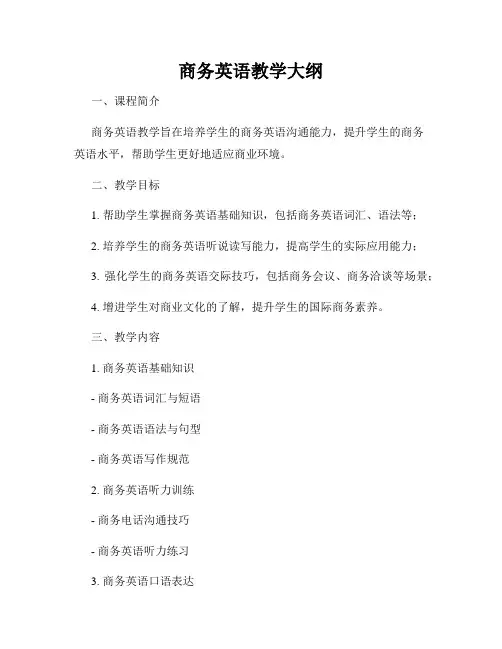
商务英语教学大纲一、课程简介商务英语教学旨在培养学生的商务英语沟通能力,提升学生的商务英语水平,帮助学生更好地适应商业环境。
二、教学目标1. 帮助学生掌握商务英语基础知识,包括商务英语词汇、语法等;2. 培养学生的商务英语听说读写能力,提高学生的实际应用能力;3. 强化学生的商务英语交际技巧,包括商务会议、商务洽谈等场景;4. 增进学生对商业文化的了解,提升学生的国际商务素养。
三、教学内容1. 商务英语基础知识- 商务英语词汇与短语- 商务英语语法与句型- 商务英语写作规范2. 商务英语听力训练- 商务电话沟通技巧- 商务英语听力练习3. 商务英语口语表达- 商务英语日常用语- 商务英语口头表达技巧- 商务英语演讲技巧4. 商务英语阅读理解- 商务英语邮件写作技巧- 商务英语报告阅读5. 商务英语写作能力- 商务英语邮件写作规范- 商务英语报告写作技巧6. 商务英语交际技巧- 商务会议技巧- 商务洽谈技巧四、教学方法1. 教师讲授2. 学生讨论3. 小组合作4. 案例分析5. 角色扮演6. 实践操作五、考核方式1. 笔试2. 口试3. 作业4. 课堂表现评定六、教材商务英语教学大纲将结合商务英语教材进行教学,教材将由教师推荐并提供相关资源。
七、教学安排商务英语教学大纲将根据具体情况确定上课时间、地点和学时安排,确保学生能够充分参与课程学习。
八、总结商务英语教学大纲旨在为学生提供一套系统的商务英语学习计划,帮助学生全面提升商务英语能力,更好地适应商业环境,实现个人发展目标。
愿学生在商务英语学习中取得出色成绩,成为国际商务领域的精英人才。
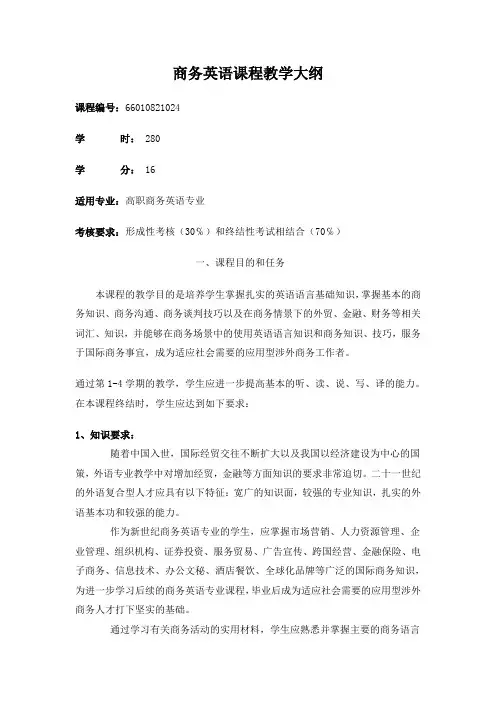
商务英语课程教学大纲课程编号:66010821024学时:280学分: 16适用专业:高职商务英语专业考核要求:形成性考核(30℅)和终结性考试相结合(70℅)一、课程目的和任务本课程的教学目的是培养学生掌握扎实的英语语言基础知识,掌握基本的商务知识、商务沟通、商务谈判技巧以及在商务情景下的外贸、金融、财务等相关词汇、知识,并能够在商务场景中的使用英语语言知识和商务知识、技巧,服务于国际商务事宜,成为适应社会需要的应用型涉外商务工作者。
通过第1-4学期的教学,学生应进一步提高基本的听、读、说、写、译的能力。
在本课程终结时,学生应达到如下要求:1、知识要求:随着中国入世,国际经贸交往不断扩大以及我国以经济建设为中心的国策,外语专业教学中对增加经贸,金融等方面知识的要求非常迫切。
二十一世纪的外语复合型人才应具有以下特征:宽广的知识面,较强的专业知识,扎实的外语基本功和较强的能力。
作为新世纪商务英语专业的学生,应掌握市场营销、人力资源管理、企业管理、组织机构、证券投资、服务贸易、广告宣传、跨国经营、金融保险、电子商务、信息技术、办公文秘、酒店餐饮、全球化品牌等广泛的国际商务知识,为进一步学习后续的商务英语专业课程,毕业后成为适应社会需要的应用型涉外商务人才打下坚实的基础。
通过学习有关商务活动的实用材料,学生应熟悉并掌握主要的商务语言和用法,并注重交际能力,合作能力,处理商务及外事的能力,独立提出建议和讨论问题的能力等的培养。
2、技能要求:1)听力方面学生能听懂正常语速为每分钟约140-180个单词的日常生活和商务活动的谈话,类型涉及电话,采访,讨论,演讲,会议发言等。
要求学生能正确辨认听觉信息,并做出适当判断,并能结合具体语言环境,理解所听内容的深层含义,把握说话者的态度和意图。
2)阅读方面能看懂图表,正确理解商务专业词汇,能读懂英美报刊杂志上中等难度的商务英语文章,了解作者的观点与态度,把握其内涵,获取准确信息,阅读速度在每分钟120-180个单词。
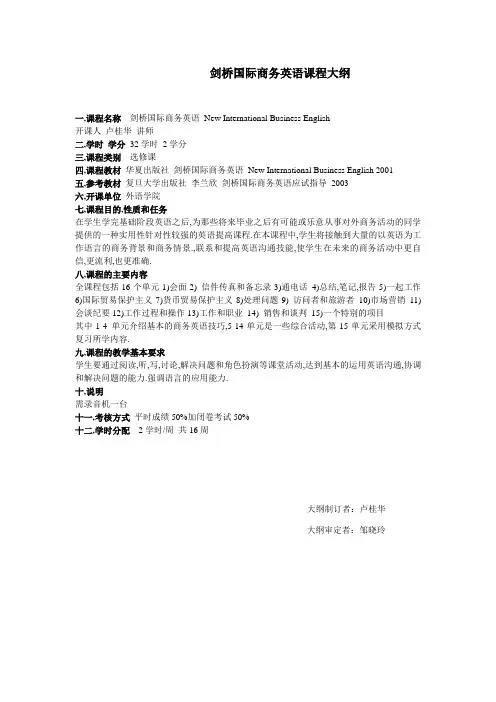
剑桥国际商务英语课程大纲一,课程名称剑桥国际商务英语New International Business English开课人卢桂华讲师二,学时学分32学时2学分三,课程类别选修课四,课程教材华夏出版社剑桥国际商务英语New International Business English 2001五,参考教材复旦大学出版社李兰欣剑桥国际商务英语应试指导2003六,开课单位外语学院七,课程目的,性质和任务在学生学完基础阶段英语之后,为那些将来毕业之后有可能或乐意从事对外商务活动的同学提供的一种实用性针对性较强的英语提高课程.在本课程中,学生将接触到大量的以英语为工作语言的商务背景和商务情景.,联系和提高英语沟通技能,使学生在未来的商务活动中更自信,更流利,也更准确.八,课程的主要内容全课程包括16个单元1)会面2) 信件传真和备忘录3)通电话4)总结,笔记,报告5)一起工作6)国际贸易保护主义7)货币贸易保护主义8)处理问题9) 访问者和旅游者10)市场营销11)会谈纪要12)工作过程和操作13)工作和职业14) 销售和谈判15)一个特别的项目其中1-4 单元介绍基本的商务英语技巧,5-14单元是一些综合活动,第15单元采用模拟方式复习所学内容.九,课程的教学基本要求学生要通过阅读,听,写,讨论,解决问题和角色扮演等课堂活动,达到基本的运用英语沟通,协调和解决问题的能力.强调语言的应用能力.十,说明需录音机一台十一,考核方式平时成绩50%加闭卷考试50%十二,学时分配2学时/周共16周大纲制订者:卢桂华大纲审定者:邹晓玲剑桥国际商务英语1 课程中文名称剑桥国际商务英语New International Business English开课人卢桂华讲师2 学时学分32学时2学分3 课程类别选修课4 预修课程大学英语5内容简介全课程包括16个单元1)会面2) 信件传真和备忘录3)通电话4)总结,笔记,报告5)一起工作6)国际贸易保护主义7)货币贸易保护主义8)处理问题9) 访问者和旅游者10)市场营销11)会谈纪要12)工作过程和操作13)工作和职业14) 销售和谈判15)一个特别的项目其中1-4 单元介绍基本的商务英语技巧,5-14单元是一些综合活动,第15单元采用模拟方式复习所学内容.学生要通过阅读,听,写,讨论,解决问题和角色扮演等课堂活动,达到基本的运用英语沟通,协调和解决问题的能力.强调语言的应用能力.6 课程教材剑桥国际商务英语New International Business English华夏出版社20017 参考书复旦大学出版社李兰欣剑桥国际商务英语应试指导20038 选课对象已通过英语四级的本科生研究生9 开课单位外语学院商务英语阅读课程教学大纲一、课程名称:《商务英语阅读》(English Readings in International Business)课程负责人:朱万忠二、学时与学分:32学时2学分三、课程类别:文化素质教育选修课四、课程教材:陈苏东,陈建平主编,《商务英语阅读》,北京:高等教育出版社,2002五、参考教材:熊伟编著, 《国际贸易实务英语》,武汉:武汉大学出版社,2001六、开课单位:重庆大学外国语学院七、课程的目的、性质和任务“商务英语阅读”使实用性很强的课程,以西方报刊中报到和论述国际商务的文章为主要内容,集英语语言学习和国际商务知识的传授为一体,通过有指导的阅读和训练,使学生掌握这类文章的文体、语言和内容特点,提高语言理解和欣赏能力,培养学生收集、整理和研究国际商务信息的能力,锻炼其逻辑思维能力,扩大其国际商务背景知识。
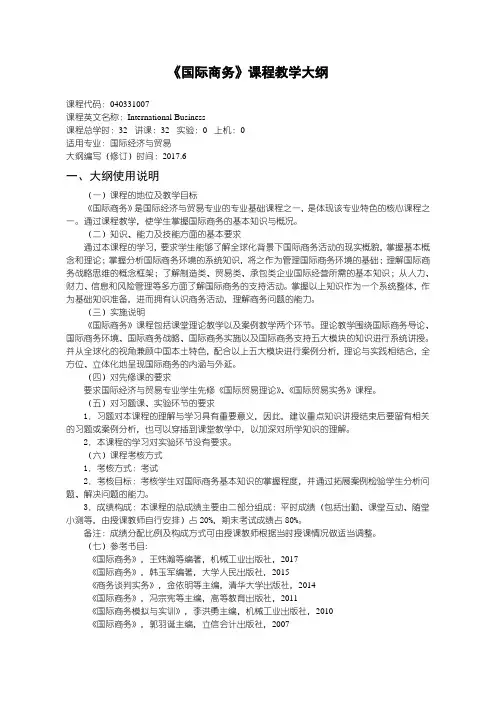
《国际商务》课程教学大纲课程代码:040331007课程英文名称:International Business课程总学时:32 讲课:32 实验:0 上机:0适用专业:国际经济与贸易大纲编写(修订)时间:2017.6一、大纲使用说明(一)课程的地位及教学目标《国际商务》是国际经济与贸易专业的专业基础课程之一,是体现该专业特色的核心课程之一。
通过课程教学,使学生掌握国际商务的基本知识与概况。
(二)知识、能力及技能方面的基本要求通过本课程的学习,要求学生能够了解全球化背景下国际商务活动的现实概貌,掌握基本概念和理论;掌握分析国际商务环境的系统知识,将之作为管理国际商务环境的基础;理解国际商务战略思维的概念框架;了解制造类、贸易类、承包类企业国际经营所需的基本知识;从人力、财力、信息和风险管理等多方面了解国际商务的支持活动。
掌握以上知识作为一个系统整体,作为基础知识准备,进而拥有认识商务活动,理解商务问题的能力。
(三)实施说明《国际商务》课程包括课堂理论教学以及案例教学两个环节。
理论教学围绕国际商务导论、国际商务环境、国际商务战略、国际商务实施以及国际商务支持五大模块的知识进行系统讲授。
并从全球化的视角兼顾中国本土特色,配合以上五大模块进行案例分析,理论与实践相结合,全方位、立体化地呈现国际商务的内涵与外延。
(四)对先修课的要求要求国际经济与贸易专业学生先修《国际贸易理论》、《国际贸易实务》课程。
(五)对习题课、实验环节的要求1.习题对本课程的理解与学习具有重要意义,因此,建议重点知识讲授结束后要留有相关的习题或案例分析,也可以穿插到课堂教学中,以加深对所学知识的理解。
2.本课程的学习对实验环节没有要求。
(六)课程考核方式1.考核方式:考试2.考核目标:考核学生对国际商务基本知识的掌握程度,并通过拓展案例检验学生分析问题、解决问题的能力。
3.成绩构成:本课程的总成绩主要由二部分组成:平时成绩(包括出勤、课堂互动、随堂小测等,由授课教师自行安排)占20%,期末考试成绩占80%。
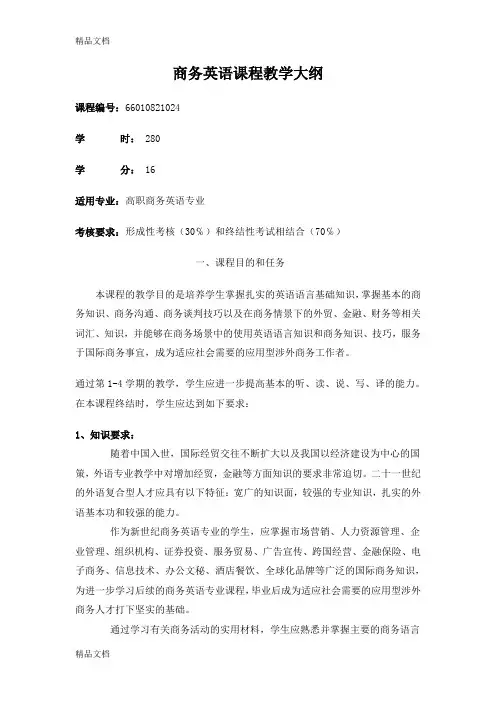
商务英语课程教学大纲课程编号:66010821024学时:280学分: 16适用专业:高职商务英语专业考核要求:形成性考核(30℅)和终结性考试相结合(70℅)一、课程目的和任务本课程的教学目的是培养学生掌握扎实的英语语言基础知识,掌握基本的商务知识、商务沟通、商务谈判技巧以及在商务情景下的外贸、金融、财务等相关词汇、知识,并能够在商务场景中的使用英语语言知识和商务知识、技巧,服务于国际商务事宜,成为适应社会需要的应用型涉外商务工作者。
通过第1-4学期的教学,学生应进一步提高基本的听、读、说、写、译的能力。
在本课程终结时,学生应达到如下要求:1、知识要求:随着中国入世,国际经贸交往不断扩大以及我国以经济建设为中心的国策,外语专业教学中对增加经贸,金融等方面知识的要求非常迫切。
二十一世纪的外语复合型人才应具有以下特征:宽广的知识面,较强的专业知识,扎实的外语基本功和较强的能力。
作为新世纪商务英语专业的学生,应掌握市场营销、人力资源管理、企业管理、组织机构、证券投资、服务贸易、广告宣传、跨国经营、金融保险、电子商务、信息技术、办公文秘、酒店餐饮、全球化品牌等广泛的国际商务知识,为进一步学习后续的商务英语专业课程,毕业后成为适应社会需要的应用型涉外商务人才打下坚实的基础。
通过学习有关商务活动的实用材料,学生应熟悉并掌握主要的商务语言和用法,并注重交际能力,合作能力,处理商务及外事的能力,独立提出建议和讨论问题的能力等的培养。
2、技能要求:1)听力方面学生能听懂正常语速为每分钟约140-180个单词的日常生活和商务活动的谈话,类型涉及电话,采访,讨论,演讲,会议发言等。
要求学生能正确辨认听觉信息,并做出适当判断,并能结合具体语言环境,理解所听内容的深层含义,把握说话者的态度和意图。
2)阅读方面能看懂图表,正确理解商务专业词汇,能读懂英美报刊杂志上中等难度的商务英语文章,了解作者的观点与态度,把握其内涵,获取准确信息,阅读速度在每分钟120-180个单词。
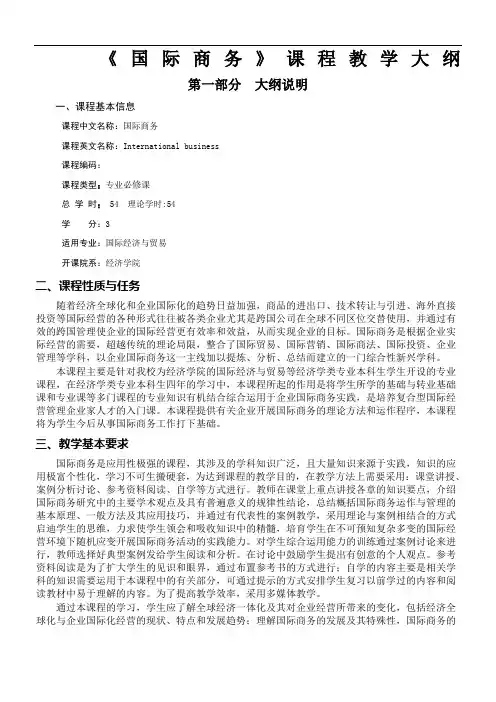
《国际商务》课程教学大纲第一部分大纲说明一、课程基本信息课程中文名称:国际商务课程英文名称:International business课程编码:课程类型:专业必修课总学时:54 理论学时:54学分:3适用专业:国际经济与贸易开课院系:经济学院二、课程性质与任务随着经济全球化和企业国际化的趋势日益加强,商品的进出口、技术转让与引进、海外直接投资等国际经营的各种形式往往被各类企业尤其是跨国公司在全球不同区位交替使用,并通过有效的跨国管理使企业的国际经营更有效率和效益,从而实现企业的目标。
国际商务是根据企业实际经营的需要,超越传统的理论局限,整合了国际贸易、国际营销、国际商法、国际投资、企业管理等学科,以企业国际商务这一主线加以提炼、分析、总结而建立的一门综合性新兴学科。
本课程主要是针对我校为经济学院的国际经济与贸易等经济学类专业本科生学生开设的专业课程,在经济学类专业本科生四年的学习中,本课程所起的作用是将学生所学的基础与转业基础课和专业课等多门课程的专业知识有机结合综合运用于企业国际商务实践,是培养复合型国际经营管理企业家人才的入门课。
本课程提供有关企业开展国际商务的理论方法和运作程序,本课程将为学生今后从事国际商务工作打下基础。
三、教学基本要求国际商务是应用性极强的课程,其涉及的学科知识广泛,且大量知识来源于实践,知识的应用极富个性化,学习不可生搬硬套,为达到课程的教学目的,在教学方法上需要采用:课堂讲授、案例分析讨论、参考资料阅读、自学等方式进行。
教师在课堂上重点讲授各章的知识要点,介绍国际商务研究中的主要学术观点及具有普遍意义的规律性结论,总结概括国际商务运作与管理的基本原理、一般方法及其应用技巧,并通过有代表性的案例教学,采用理论与案例相结合的方式启迪学生的思维,力求使学生领会和吸收知识中的精髓,培育学生在不可预知复杂多变的国际经营环境下随机应变开展国际商务活动的实践能力。
对学生综合运用能力的训练通过案例讨论来进行,教师选择好典型案例发给学生阅读和分析。
商务英语课程教学大纲《商务英语》课程教学大纲一、课程性质和任务商务英语是英语专业商务方向的课程,通过本课程的学习,学生应掌握商务英语交流的基本技能,通过学习有关商务活动的真实语言材料,学生应熟悉并掌握当代商务理念和国际商务惯例;加强对不同社会和商业文化的认知;学习进行国际商务交际的基本策略,提高作为商务工作者的基本素质;成为具有较强的商务交际能力、团队协作精神和创新意识的国际化商务人材。
通过学习,学生应具有一定的听、说、读、写、译能力,能够在不同的商务活动中正确使用英语。
二、教学要求1、词汇领会式掌握1800单词(其中熟练掌握的单词为800),以及由这些词构成的常用词组,并具有按照构词法识别生词的能力。
2、阅读能力能顺利阅读语言难度中等的商务题材的文章,掌握中心大意以及说明中心大意的事实和细节,并能就文章的内容进行分析、推理、判断和综合概括,领会作者的观点和态度,阅读速度达到每分钟80词。
在阅读篇幅较长、难度略低、生词不超过总词数5%的材料时,能正确理解中心大意,抓住主要实施和有关细节,阅读速度达到每分钟80词。
3、听的能力对题材熟悉、句子结构不太复杂、生词少、语速为每分钟80~100词的篇幅较长的会话、谈话报道和讲座,能掌握其中心大意,抓住要点和有关细节,领会讲话者的观点和态度,并能进行分析、推理和判断。
4、说的能力能就教材内容和一般的听力材料进行问答和讨论,能就一般的社会生活话题进行简单的交谈讨论和发言,表达思想清楚,语音、语调基本正确。
5、写的能力能在阅读难度与课文相仿的书面材料时做笔记、回答问题、写提纲和摘要、能就一定的话题、提纲、表格或图示在半小时内写出80~100的短文,能写商务应用文(如信函、简历等),内容完整,条理清楚,文理通顺。
6、译的能力能借助词典将难度略低于课文的英语短文译成汉语,理解正确,译文达意,译速为每小时200英语单词。
能借助词典将内容熟悉的汉语文字材料译成英语,译文达意,无重大语言错误,译速为每小时180汉字。
《International Business》(English) SyllabusCourse Code:030933ACourse Type:Obligatory CoursePeriods:48Theoretical part:32Practical Part:16Credit:3Target students:International Economics and TradePreparatory Courses:International Economics, International trade,International Finance1、Objectives"International Business" (English) is an international trade professional foundational course, targeted professional courses in English learning environment for students. This course introduces the background of economic globalization; international companies how to conduct international business activities and cross-border business activities. Including how-to-business environment in which international and national environmental evaluation of country analysis, enterpriseinter nationalization, globalization theory, international business strategy ,international business activities, entry mode selection, international business executives etc,so as to cultivate an international perspective theory in practice for students.2.Basic Requirements(1) Main ContentsThe courseis divided in to the oretical part and practical part, the theoretical part includes business culture, international business negotiations, international trade, international finance, international marketing, international strategic planning, international businessman agement, etc.; practical part using CESIM combat simulation software to run International Business, related to strategic planning, financial involve global logistics planning, cross-border investment, internationaltrade practices and other content.(2)Teaching MethodThis course teaches the theory and case studies taken combined. Teaching content of each chapter to take into account the combination of both social realities and trends, and also have the focus, combined with cutting-edge issues of commercial culture, arrange some discussion to the depth and breadth.(3) Assessment:ExaminationThe course is assessed by final exam, attendance, presentation. Final Exam: 70%; Practices with CESIM Global Challenge 20%, attendance presentation 10 %.(4) Learning RequirementsBefore learning this course, students should grasp the relevant international economics, international trade, international finance and other related courses as a basis. To adhere to the theory and practice of combining the principles of learning and using a combination of, students analyze and judge, this course will combine the cortical study and practical application of the principles, theory courses, will organize a panel discussion on the theme of international business exchange of relevant issues, including the submission of a written report to discuss the results and classroom presentation. The main advantage of the practical aspects simulation software, the sub-group global strategic lay out planning, the actual simulation performance evaluation results as a group.3. Arrangements4. SyllabusChapter 1 GlobalizationThis chapter introduces the emergence of the globally integrated business world. Globalization has reduced the traditional barriers to cross-border trade and investment (distance, time zones, language, differences in government regulations, culture, and business systems).Learning objectives:●Understand what is meant by the term globalization.●Recognize the main drivers of globalization.●Describe the changing nature of the global economy.●Explain the major arguments in the debate over the impact of globalization.●Understand how the process of globalization is creating opportunities andchallenges for business managers.Chapter 2 National Differences in Political EconomyThis chapter discusses differences in national political, economic, and legal systems, highlighting the ways in which managers in global settings need to be sensitive to these differences.Learning objectives:●Understand how the political systems of countries differ.●Understand how the economic systems of countries differ.●Understand how the legal systems of countries differ.●Explain the implications for management practice of national differences inpolitical economy.Chapter 3 Political Economy andEconomic DevelopmentThis chapter discusses differences in national political, economic, and legal systems, highlighting the ways in which managers in global settings need to be sensitive to these differences.Learning objectives:●Explain what determines the level of economic development of a nation.●Identify the macro-political and economic changes taking place worldwide.●Describe how transition economies are moving towards market based systems.●Explain the implications for management practice of national differences inpolitical economy.Chapter 4 Differences in CultureThis chapter explores the role of culture in international business: how differences in culture across and within countries can affect the practice of business.Learning objectives:●Know what is meant by the culture of a society.●Identify the sources that lead to differences in social culture.●Identify the business and economic implications of differences in culture.●Understand how differences in social culture influence values in the work place.●Develop an appreciation for the economic and business implications of culturalchange.Chapter 5 Business EthicsThis chapter looks at ethics in international business. Ethics becomes an issue across nations because of differing political systems, economic systems, legal systems and cultural values. What is acceptable behavior in one nation may be considered unethical in another.Learning objectives:●Understand the ethical issues faced by international businesses.●Recognize an ethical dilemma.●Identify the causes of unethical behavior by managers.●Describe the different philosophical approaches to ethics.●Explain how managers can incorporate ethical considerations into their decisionmaking.Chapter 6 International Trade TheoriesThis chapter presents the major theories of international trade. Scholars first began to offer explanations for trade in the fifteenth century. Since then, various trade theories have developed, along with efforts to refine them.Learning objectives:●Understand why na tions trade with each other.●Summarize the different theories explaining trade flows between nations.●Recognize why many economists believe that unrestricted free trade betweennations will raise the economic welfare of countries that participate in a free trade system.●Explain the arguments of those who maintain that government can play aproactive role in promoting national competitive advantage in certain industries.●Understand the important implications that international trade theory holds forbusiness practice.Chapter 7 The Political Economy of International TradeThis chapter focuses on the political systems and tools of trade policy. The major objective of this chapter is to describe how political realities shape the international trading system.Learning objectives:•Identify the policy instruments used by governments to influence international trade flows.•Understand why governments sometimes intervene in international trade. •Summarize and explain the arguments against strategic trade policy.•Describe the developments of the world trading system and the current trade issues. •Explain the implications for managers of developments in the world trade system.Chapter 8 Foreign Direct InvestmentThe focus of this chapter is foreign direct investment (FDI). The growth of foreign direct investment in the last 25 years has been phenomenal. FDI can take the form of a foreign firm buying a firm in a different country, or deciding to invest in a different country by building operations there.Learning objectives:•Recognize current trends regarding FDI in the world economy.•Explain the different theories of foreign direct investment.•Understand how political ideology shapes a government’s attitudes towards FDI.•Describe the benefits and costs of FDI to home and host countries.•Explain the range of policy instruments that governments use to influence FDI. •Identify the implications for management practice of the theory and government policies associated with FDI.Chapter 9 Regional Economic IntegrationThis chapter discusses regional economic integration, agreements among countries within a geographic region to achieve economic gains from the free flow of trade and investment among themselves.Learning objectives:•Describe the different levels of regional economic integration.•Understand the economic and political arguments for regional economic integration.•Understand the economic and political arguments against regional economic integration.•Explain the history, current scope, and future prospects of the wor ld’s most important regional economic agreements.•Understand the implications for business that are inherent in regional economic integration agreements.Chapter 10 Foreign Exchange MarketThe foreign exchange market is the market where currencies are bought and sold and currency prices are determined. It is a network of banks, brokers and dealers that exchange currencies 24 hours a day.Learning objectives:•Describe the functions of the foreign exchange market.•Understand what is meant by spot exchange rates.•Recognize the role that foreign exchange rates play in insuring against foreign exchange risk.•Understand the different theories explaining how currency exchange rates are determined and their relative merits.•Identify the merits of different approaches towards exchange rate forecasting. •Compare and contrast the differences between transaction, translation, and economic exposure, and what managers do to manage each type of exposure.Chapter 11 International Monetary SystemThis chapter discusses the evolution of the international monetary system and the implications of this system for international business, focusing on the institutional context within which exchange rates move.Learning objectives:•Describe the historical development of the modern global monetary system. •Explain the role played by the World Bank and the IMF in the international monetary system.•Compare and contrast the differences between a fixed and a floating exchange rate system.•Identify exchange rate systems that are used in the world today and why countries adopt different exchange rate regimes.•Understand the debate surrounding the role of the IMF in the management of financial crises.•Explain the implications of the global monetary system for currency management and business strategy.Chapter 12 International Financial MarketsThis chapter discusses the form and function of the global capital market. The market is attractive because its size lowers the cost of capital for borrowers, and allows investors to diversify their portfolios, thereby reducing their risk.Learning objectives:•Describe the benefits of the global capital market.•Identify why the global capital market has grown so rapidly over the last quarter century.•Understand the risks associated with the globalization of capital markets. •Compare and contrast the risks and benefits associated with the Eurocurrency market, the global bond market, and the global equity markets.•Understand how foreign exchange risk impacts upon the cost of capital.Chapter 13 International StrategyIn this chapter the focus shifts from the environment to the firm itself and, inparticular, to the actions managers can take to compete more effectively as an international business.Learning objectives:•Explain the concept of strategy.•Recognize how firms can profit from expanding globally.•Understand how pressures for cost reductions and pressures for local responsiveness influence strategic choice.•Identify the different strategies for competing globally and their pros and cons.Chapter 14 The Organization of International BusinessThis chapter identifies the organizational architecture that international businesses use to manage and direct global operations. The core argument outlined in this chapter is that superior enterprise profitability requires three conditions: First, the different elements of a firm’s organizational architecture must be internally consistent.Second, the organizational architecture must match or fit the strategy of the firm—strategy and architecture must be consistent.Third, the strategy and architecture of the firm must be consistent with competitive conditions prevailing in the market place.Learning objectives:•Explain what is meant by organizational architecture.•Describe the different organizational choices that can be made in an international business.•Explain how organization can be matched to strategy to improve the performance of an international business.•Discuss what is required for an international business to change its organization so that it better matches its strategy.Chapter 15 Entry Strategy and Strategic AlliancesThis chapter is concerned with three closely related topics: the decisions ofwhich markets to enter, when to enter those markets, and on what scale.Learning objectives:•Explain the three basic differences that firms contemplating foreign expansion must make: which markets to enter, when to enter those markets, and on whatscale.•Compare and contrast the different modes that firms use to enter foreign markets. •Identify the factors that influence a firm’s choice of entry strategy.•Recognize the pros and cons of acquisitions versus greenfield ventures as an entry strategy.•Evaluate the pros and cons of entering into strategic alliances.Chapter 16 Exporting, Importing and CountertradePrevious chapters have presented exporting as just one of a range of strategic options for profiting from international markets. This chapter looks more at the nuts and bolts of how to export.Learning objectives:•Explain the promises and risks associated with exporting.•Identify the steps managers can take to improve their firm’s export performance.•Identify information sources and government programs that exist to help exporters.•Recognize the basic steps involved in export financing.•Describe how countertrade can be used to facilitate exporting.Chapter 17 Global Production, Outsourcing, and LogisticsThis chapter focuses on two major activities—production and materials management, and attempts to clarify how when they are performed internationally, the cost of value creation can be lowered, and how value can be added by better serving customer needs.The choice of an optimal manufacturing location must consider country factors, technological factors, and product factors.Foreign factories can improve their capabilities over time, and this can be of immense strategic benefit to the firm. Managers need to view foreign factories as potential centers of excellence and encourage and foster attempts by local managers to upgrade factory capabilities.An essential issue in many international businesses is determining which component parts should be manufactured in-house and which should be outsourced to independent suppliers.The chapter also discusses the contributions of information technology to these activities. This is especially important in the era of the Internet.Learning objectives:•Explain why production and logistics decisions are of central importance to many multinational businesses.•Explain how country differences, production technology, and product features all affect the choice of where to locate production activities.•Recognize how the role of foreign subsidiaries in production can be enhanced over time as they accumulate knowledge.•Identify the factors that influence a firm’s dec ision of whether to source supplies from within the company or from foreign suppliers.•Describe what is required to efficiently coordinate a globally dispersed production system.Chapter 18 Global Marketing and R&DThe focus of this chapter is on how marketing and R&D can be performed so they will reduce the costs of value creation and add value by better serving customer needs.A global marketing strategy that views the world’s consumers as similar in their tastes and preferences is consistent with the mass production of a standardized output. By mass-producing a standardized output, the firm can realize substantial unit costreductions from experience curve and other scale economies. But ignoring country differences in consumer tastes and preferences can lead to failure. Thus, an international business’s marketing function needs to determine when product standardization is appropriate and when it is not, and adjust the marketing strategy accordingly. Similarly, the firm’s R&D function needs to develop g lobally standardized products when appropriate as well as products that are customized to local requirements.Learning objectives:•Explain why it makes sense to vary the attributes of a product from country to country.•Recognize why and how a firm’s distri bution strategy might vary among countries.•Identify how and why advertising and promotion strategies might vary among countries.•Explain how and why a firm’s pricing strategy might vary among countries.•Describe how the globalization of the world’s econ omy is affecting new product development within the international business firm.Chapter 19 Hiring and Managing EmployeesHuman resource management is key to the competitiveness of international firms.HRM refers to those activities undertaken by an organization to effectively apply its human resources. These activities include human resource strategy, staffing, performance evaluation, management development, compensation, and labor relations.Firm success requires that HRM policies are congruent with strategy and with formal and informal structure and controls. Strategies like “think globally and act locally” sound good, but to be successfully implemented, effective HRM policies are necessary.Learning objectives:•Summarize the strategic role of human resource management in the international business.•Identify the pros and cons of different approaches to staffing policy in the international business.•Explain why managers may fail to thrive in foreign postings.•Recognize how management development and training programs can increase the value of human capital in the international business firm.•Explain how and why performance appraisal systems might vary across nations. o Understand how and why compensation systems might vary across nations.o Understand how organized labor can influence strategic choices in the international business firm.Chapter 20 Hiring and Managing EmployeesThis chapter deals with accounting and financial management in international business. It illustrates and explains how accounting decisions, investment decisions, financing decisions, and money management decisions are complicated by different currencies, different tax regimes, different levels of political and economic risk, and so on.Learning objectives:•Discuss the national differences in accounting standards.•Explain the implications of the rise of international accounting standards. •Explain how accounting systems impact upon control systems within the multinational enterprise.•Discuss how operating in different nations impacts investment decisions within the multinational enterprise.•Discuss the different financing options available to the subsidiary of a multinational enterprise.•Understand how money management in the international business can be used to minimize cash balances, transaction costs, and taxation.•Understand the basic techniques for global money management.5. Reference BookCharles W.L. Hill, <International Business>,王蔷改编,中国人民大学出版社,2013执笔人:教研室主任:刘宏系教学主任审核签名:。